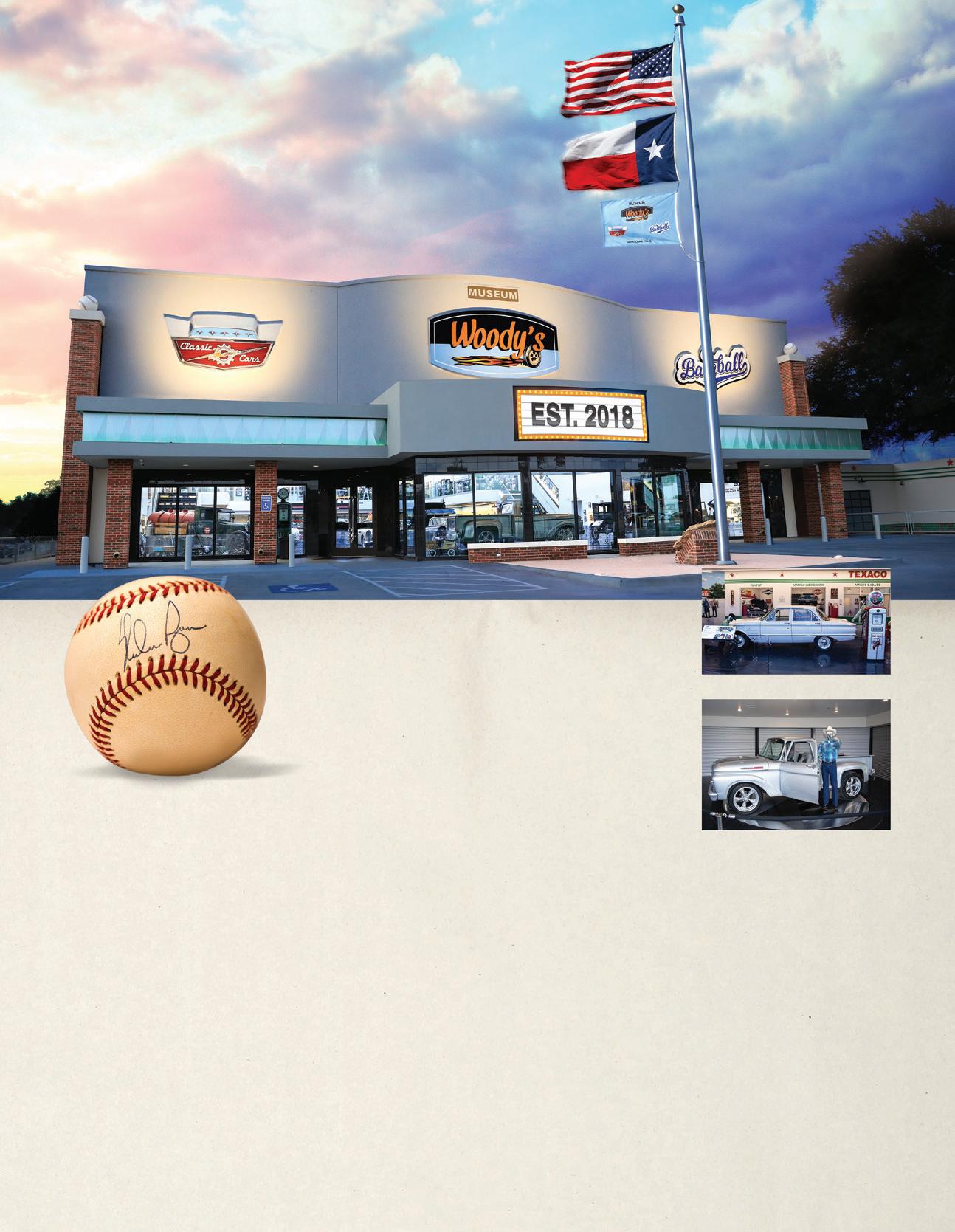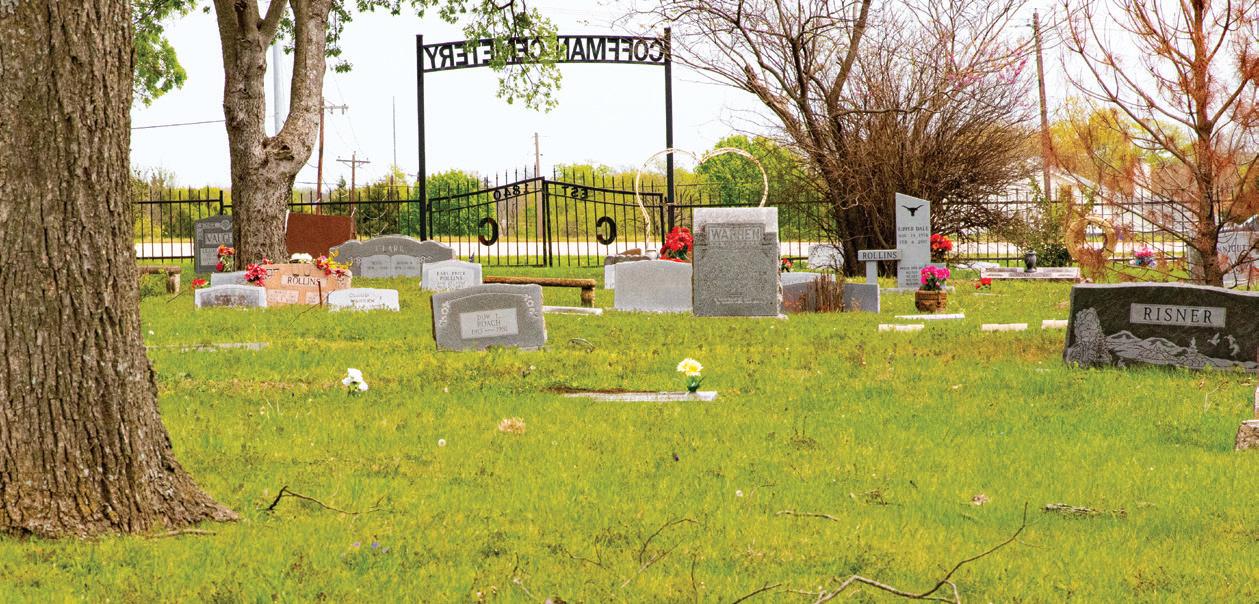
11 minute read
A BIT OF ANNA HISTORY
Coffman Community West of Anna Has Rich Farming History
By Jan Sherley Miller
Advertisement
Photo by Joyce Godwin
Part of the Coffman Cemetery is seen here with a mixture of recent and very old grave markers. It is the only structure of any kind remaining from the historic Coffman Community west of Anna. It is located on the service road of U.S. Highway 75 south of White Street/ F.M. 455.
John Coffman (7-3-1804: 2-15-1880) was one of the earliest settlers of this area, coming in 1843. John met Elizabeth Witt in Jefferson County, Tennessee, and they were married on February 15, 1828. With their respective families, they migrated the following year to Illinois, likely Greene County on the Illinois River and two counties above St. Louis. Here, eight of their 12 children were born. Obtaining some land in the Peter’s Colony in 1843, John brought his family to Texas to settle in 1844. John, an accomplished farmer, and Elizabeth established their home three miles west of the present town of Anna. Four more children were born there. Known to be a devout Christian, Elizabeth with her husband became charter members with six other people of a Baptist Church in 1850.
In the 1840s, John allocated some land on the southern boundary of his farm for a cemetery. There he and Elizabeth are buried, as well as his son George and his wife, Mittie Jane. John left his land to his sons, not without causing some resentment among his daughters. Perhaps he reasoned that their husbands should provide for them, or that he desired above all, that the land they had struggled to acquire should be maintained by male descendants as “Coffman” land. Ironically and tragically, the male line expired on the death of Scott Coffman, 1965, grandson of John Hogan (Coffman), but the farm has retained its name through descendants of Quincy, his granddaughter and daughter of his son George.
John would have been very pleased if he could realize that the Coffman farm still exists to this day. It is owned by his great, great, great grandchildren. The land was designated by the Texas Agriculture Department in 1974 to the Texas Family Land Heritage Program. This honor is “for century or more continuous ownership and operation as a family agricultural enterprise. To the dedication and perseverance of the founders and heirs of these lands, we owe the basis of wealth of Texas.” This is the oldest such farm in Collin County.
Coffman Cemetery is still “alive.” The oldest standing marker in the cemetery is that of Alfred Dupry (5-22-1852: 3-8-1876). There were earlier graves with wooden markers that have been destroyed. As one enters the gate on the east, there is a large bois d’arc post that is believed to be one of the earliest graves. The steel fence surrounding the cemetery is the original one put up many years ago. The cattle grazing in the area were beginning to present problems at burials. The Coffman Cemetery Association erected a new fence in 2009. Some of the old fence was sold in pieces to families of people buried in the cemetery to help pay for the new fence.
Pitt’s 1971 Original Survey of Burials, speaks of the cemetery as the Coffman-Rollins Cemetery. This is understandable since the majority of those buried are descendants of James Rollins (1-1-1837: 3-28-1910), who settled west of the Coffman Cemetery. All the early burials were conducted by Sherley Bros. of Anna.
The cemetery remains faithful to its beginning. There is no charge to be buried here, you must be a direct descendant of one of the original families or have married one. A historical marker was dedicated on Oct. 18, 1987. Alma Littrell, who had been secretary of the cemetery board for years and who wrote the history of the community and of the cemetery (in order to procure a marker), ironically was buried the same day as the marker dedication.
George Coffman, son of John, had a home to the southwest of the cemetery. His granddaughter Lorraine recalled what a well-kept, beautiful place it was with the house trimmed in gingerbread (style), the extensive barns so well-tended, and the garden and orchard that were so productive. George was one of the most successful farmers and livestock breeders of the county. He was a breeder of jacks and jennies (donkeys) and prided himself on raising choice big, heavy mules so necessary to farming and for use as draft animals. Mule buyers came many miles to his farm to supply their needs. Before the railroad, many crops, such as cotton, were shipped to Jefferson, Texas by wagons,
which returned with needed goods for the area.
During George Coffman’s ownership of the land, he allocated land for a community store and a schoolhouse. The Coffman community was one-half mile west of the cemetery and consisted of a school and a store owned by W.J. Howell (10-30-1852: 1-18-1921).
Mr. and Mrs. Howell, fondly known as Uncle Billy and Aunt Lizzie, had a store at the crossroads known as King’s Trail. Running north and south was a portion of the King’s Trail, which extended from McKinney to Sherman, now known as Telephone Road. This joined the east-west road at the store. Across the road from the store was a a long row of mailboxes, the Coffman post office. This store was the community gathering place but remained rather quiet until the gypsies that traveled the King’s Trail made their yearly stop. As the gypsy men gathered on the store porch, the women swished their coin-ornamented braids about their shoulders and asked the local men to extend their hands to have their fortunes told. During all the excitement, Uncle Billy and Aunt Lizzie were keeping close watch on their goods, many in open barrels. The store closed at the death of Uncle Billy in 1921, after which the locals would travel to the store at Kelly, approximately two miles further northwest.
Apparently, Mr. Howell’s marketing skills passed down through his family, as family owned Howell’s Furniture Store operated for many years in downtown McKinney and later on Hwy. 380 just west of Hwy. 75.
One-third of the children of school age in Texas were enrolled in schools 30 years after Americans occupied the territory. “We have as yet,” recorded a pioneer on a new frontier who “had but little leisure to think on anything beyond the calls of necessity.” First was the need for food and drink, then for security, next a desire for social acceptance and affection, and finally an urge for prestige.
As an observing French commentator noted, “He was obliged to occupy himself much more with the cultivation of the earth, than of himself. Back breaking tasks must occupy the pioneer’s time from morning until night if he was to fulfill his obligation to society and start himself along the road to affluence.”
There were numerous schools dotted over the area. Highland was established in 1871, Kelly in 1889, Throckmorton (?), Mantua in 1859, Melissa free school in 1880, and Anna free school in 1883.
The little Coffman School House was established about 1890. There were several teachers over the years, some teaching for only one year. Sometimes the teachers would stay in the homes of local residents.
The one-room school, grades 1-7, was a short distance south of the Coffman store. Miss Sue Rattan, long time Anna schoolteacher for whom Rattan Elementary was name, began her long teaching career there. She was the great-granddaughter of Thomas Rattan, another early settler to the area. When Miss Sue began teaching in the 1920s, she enjoyed racing on horseback with some of her students. The ones living farther from the school would meet her at her home, and they would race the remaining way to school. It seems the boys would rather let her lead a bit because the wind would sometimes blow her skirt and expose her legs. The school closed in the early 40s with Miss Sue and the students going to Anna. There she taught several generations of students.
There were possibly two structures. There is no record of the demise of the first school. The second building was acquired by George Apple in 1941. He was superintendent of the Presbyterian Sunday school on Lamar and Kentucky and employed L.L. (Lib) Riffe of Anna to tear down the building and deliver the lumber for Sunday School rooms at the Presbyterian church. Probably the only remaining item from the school is the merry-go-round.
EDITOR’S NOTE: There are no structures left to photograph to illustrate the community of Coffman except that of the Coffman Cemetery which is still in use today for individuals who descend from Coffman residents.
More of the story of Coffman will be shared in the next issue of Anna Living Magazine. While verifying facts of this story, evidence of a murder story came to the surface. We will tell that story in our next issue.
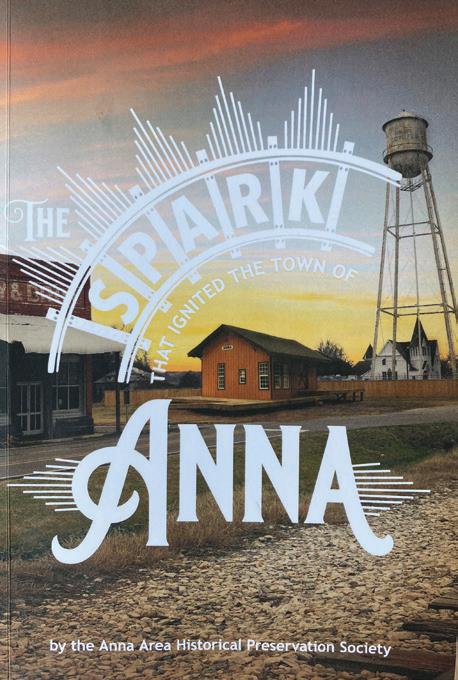
This story is reprinted here with permission from the Anna Area Historical Preservation Society. “The Spark that Ignited the Town of Anna” is a wonderful effort on behalf of the historical society that includes the stories of Anna’s leading families and efforts through the years. Anyone who may have had a curiosity about how things have happened in Anna, will likely find answers in this book. The book may be found online at www.amazon.com or by contacting the historical society whose website is http://aahps.org.
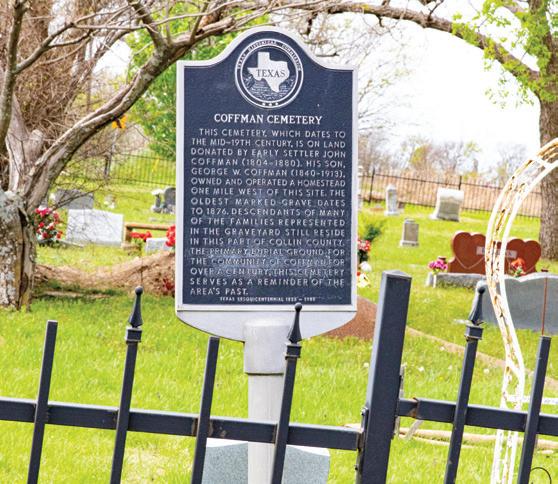
Photo by Joyce Godwin
The text on this historical marker at the front of the Coffman Cemetery states, “THIS CEMETERY, WHICH DATES TO THE MID-19TH CENTURY, IS ON LAND DONATED BY EARLY SETTLER JOHN COFFMAN (1804-1880). HIS SON, GEORGE W. COFFMAN (1940-1913), OWNED AND 0PERATED A HOMESTEAD ONE MILE WEST OF THIS SITE. THE OLDEST MARKED GRAVE DATES TO 1876. DESCENDANTS OF MANY OF THE FAMILIES REPRESENTED IN THE GRAVEYARD STILL RESIDE IN THIS PART OF COLLIN COUNTY. THE PRIMARY BURIAL GROUND FOR THE COMMUNITY OF COFFMAN FOR OVER A CENTURY, THIS CEMETERY SERVES AS A REMINDER OF THE AREA’S PAST.” — THE TEXAS SESQUICENTENNIAL 1836–1986
Anna BOYS BASEBALL
Varsity Sports Action Photos by Danny McFadden
Danny McFadden attends almost every Anna High School sporting event and enjoys taking photos which he makes available to the students at no charge. McFadden is easy to spot at just about any sporting event in Anna. You will know him because he will be looking through the super-long lens of his Canon camera. Anna Living Magazine publishes these photos with McFadden’s gracious permission.











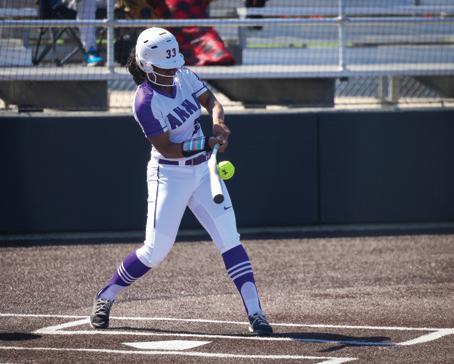

Anna Girls softball





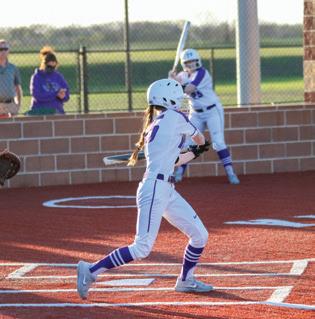


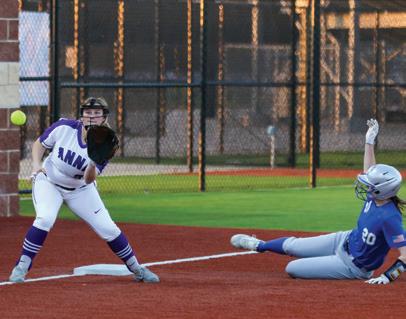
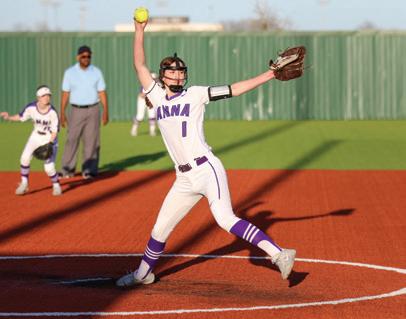
DISABLED VET OWNED, AND FAMILY OPERATED.
THROUGH ULTRA-CONCENTRATED CBD OIL DERIVED FROM ALL-NATURAL, HIGH QUALITY INDUSTRIAL HEMP!
20% DISCOUNT
The 20% discount is only valid at the Anna store location and may not be used with any other discount. Customer needs to bring the ad to receive the discount.
CBD Hemp Oil is a dietary supplement made from Industrial Hemp. CBD oil is LEGAL and AVAILABLE in all 50 states. No permit or prescription is required. Every adult U.S. citizen can now benefit from the use of CBD oil.
Proprietary Nanotechnology
CBD American Shaman’s Nanotechnology represents the ultimate refinement of hemp oil concentrate. Our unique process gives unmatched particle size, putting cannabinoids in their most bio-active state. This minute size gives the cannabinoids a much greater service area. For example: Picture a basketball full of BBs sitting on your kitchen floor. It only covers a small portion of the floor. Now, picture the basketball breaking open and all those BBs spilling out. They spread out over the entire floor. This is what our proprietary nano system does — it breaks large lipid balls full of cannabinoids down thousands of times to the molecular level. The smaller the particle size, the easier it is for the cells of your body to absorb it. Every time you cut the particle size in half, you increase its surface area. Think of the exponential surface area when you reduce particle sizes hundreds of times. This process will not only make hemp oil concentrate much more potent, it will make delivery time to the cells a matter of seconds; not hours!
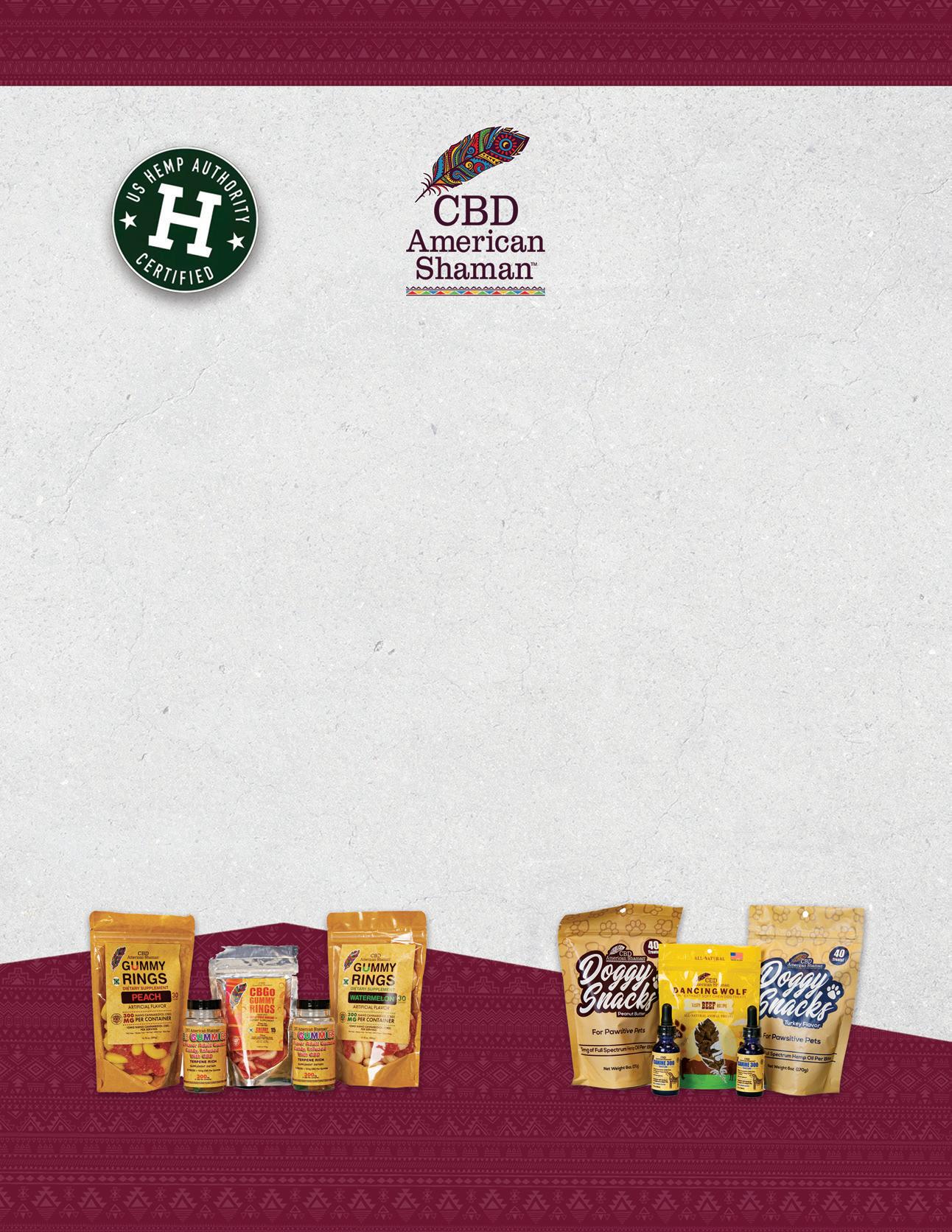
OUR PRODUCTS INCLUDE
Body Lotion Canine/Feline Tincture Capsules Clearomizers Concentrate Edibles Face Cream Hydrating Body Lotion Lip Revitalizer Pet Products Tincture Topical Cream Topical Serum Under-Eye Serum VG Cloud Tincture Water Soluble
PHONE NO ADDRESS WEBSITE
